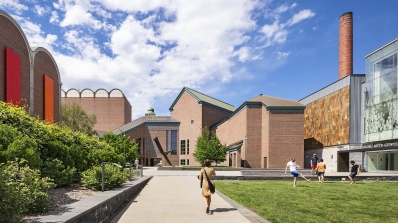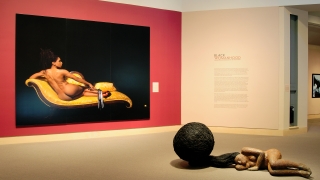Exhibitions Archive
Prints by Robert Rauschenberg
Reading ImagesRobert Rauschenberg has often been called one of the most influential American artists of the latter half of the twentieth century. He is best known for his assemblage work, in which he combined painting with found objects. While his art retained many expressionistic and painterly traits, his frequent use of materials from popular culture made him an important transitional figure between abstract expressionism and Pop Art. Rauschenberg regarded his methods as comprising a collaboration with materials rather than a conscious manipulation of them. This open-minded attitude toward art led him to experiment with a greater range of media than perhaps any other contemporary artist.
Rauschenberg's residency at Dartmouth College in 1963 marked a transitional period in his career, during which he sought alternatives to assemblage by experimenting with the printmaking process. The high level of cooperation inherent in printmaking made it especially suited to Rauschenberg, who was prone to collaborative ventures. Over the years, he worked with various printmakers and also choreographers, such as Merce Cunningham and Trisha Brown, and also arranged and performed his own pieces.
Rauschenberg's print collages incorporate both his aesthetic vision and his preoccupation with the historical, cultural, and personal layers of meaning embedded in language and images. In some cases, it helps to understand the context informing them, but this does not make their immediate aesthetic appreciation or personal interpretation any less relevant.
Private Portraits/Public Conversations
Félix de la ConchaThe Hood Museum of Art continues its series of major public art projects, in conjunction with the Dartmouth Centers Forum, in a multimedia exhibition of fifty-one portraits exploring the ways members of the Dartmouth and Upper Valley communities have encountered conflict and how they made--or are making--the journey toward reconciliation.
De la Concha's effort to capture a truthful portrait results in a multidimensional representation of his encounter with his sitters--each one is intellectually, psychologically, and emotionally charged. Each portrait session lasted two hours, during which time the artist interviewed the sitter, and video- and audio-taped the entire experience. The artist added the aspect of video recording for the Hood project as a means of reconstructing, in real time, what transpired in each two-hour session. Thus, "portrait" here comprises painted representation, spoken narrative, and the visual recording of the interaction between artist and subject.
In Black and White?
AmericaImages, Icons, and Ideologies of the African Body
Black WomanhoodFour Depictions of Women in Mid-Twentieth-Century American Art
Confronting ClassWorks from 1950 to Today
Focus on PhotographyFocus on Photography surveys the Hood Museum of Art's post-1950 photography collection concentrating on two major themes: portraiture and landscape. Bridging these two themes, a small assortment of documentary and photojournalist works will present work by major figures such as James Nachtwey, Sebastiao Salgado, and Eugene Smith. Focus on Photography maps several contemporary trends in photography including a trend towards adolescence in portraiture, the clash of man versus nature in landscape imagery, the negotiation of identity through self-portraiture, and images of the urban landscape.
In addition, Focus on Photography will trace advances in technology that drive a number of artists's work, including digital photography and computer manipulation (with artists like Loretta Lux), photogenics (Lotte Jacobi), extended exposure times (Gary Schnieder and Matthew Pillsbury) and camera obscura (Abe Morell). Even with such developments, the show will underscore how artists working today continue to draw on traditional subject matters, styles, and processes.

